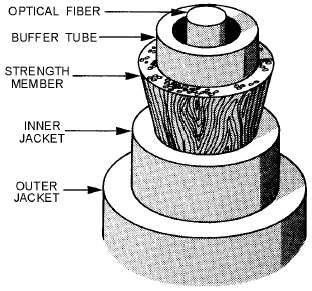2-37
small amount of power being reflected back to the transmitting device. When using a termination as a
load, you should ensure that its wattage rating exceeds the power output of the equipment to which it is
connected. You can also measure this type of termination by using a standard ohmmeter to read the
resistance between the center conductor and the shield of the rf connector.
Q-28.
What is the most common method of testing resistive terminations?
FIBER-OPTIC TESTING
Fiber optics are a relatively new type of transmission media. Figure 2-31 depicts a typical fiber-optic
cable design. The core of the fiber-optic cable is the optical transmission path, which carries data from the
optical transmitter to the optical receiver. The core is usually made of plastic, glass, or plastic-clad silica
(PCS). Glass-core fibers are usually smaller in diameter than plastic or PCS cores. The major
disadvantages of glass cores are that they have high attenuation (25 dB/km), require precision tools and
connectors, and are extremely susceptible to mechanical damage. Plastic cores are typically more rugged
than other types of cores, but their attenuation is high (35 dB/km). PCS cores are fairly rugged and have a
relatively low attenuation (10 dB/km). A fiber-optic cable may consist of one fiber, multiples of single-
optical fibers, or bundles of optical fibers. Fiber-optic cables are well suited for the transmission of high-
speed data over relatively short distances. They are virtually immune to crosstalk or interference through
inductance. (Interference is a characteristic of metallic cables.)
Figure 2-31.—Typical fiber-optic cable.
Testing techniques and the principles of measurement for fiber-optic and conventional cable are
similar. For example, if both ends of the cable are exposed and can be used for testing, relatively
unsophisticated equipment can be used to measure cable parameters, such as continuity and attenuation.
This includes equipment such as optical multimeters and optical power meters (OPM). If only one cable
end is available, then more sophisticated equipment such as an optical time-domain reflectometer
(OTDR), is used. The following section lists and defines some common optical test equipment.
Q-29.
What is the main disadvantage of using fiber-optic cables?

